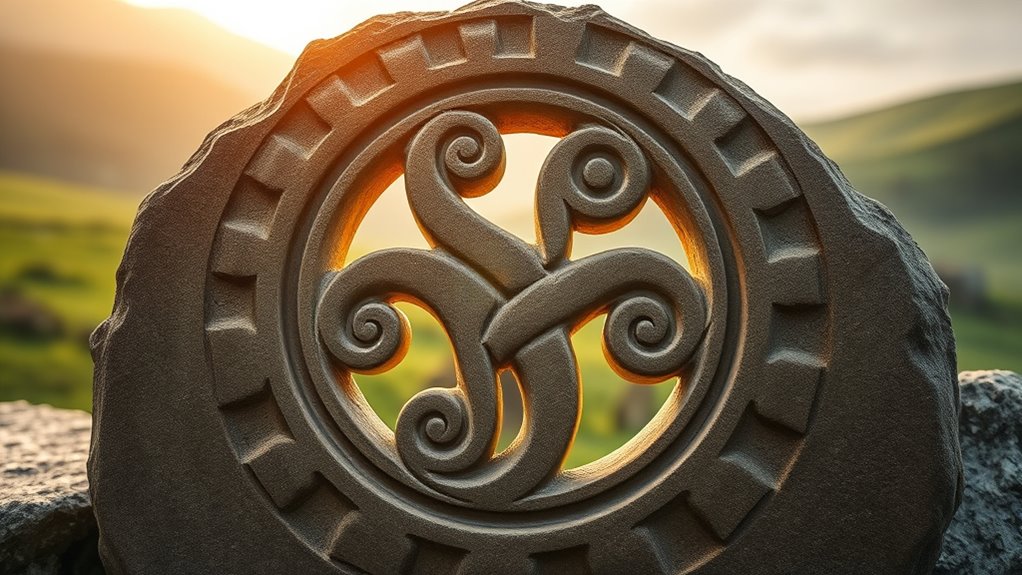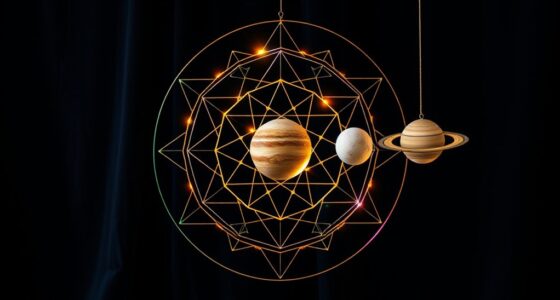The triskelion, a three-armed spiral symbol, is rooted in Celtic lore and found across many cultures. It represents cycles of life, motion, and spiritual harmony, symbolizing interconnected forces like land, sea, and sky or phases of life. Used in ancient artifacts and spiritual practices, it embodies balance, eternity, and natural flow. If you keep exploring, you’ll discover how this powerful symbol continues to inspire modern interpretations across the world.
Key Takeaways
- The triskelion is a Celtic symbol featuring three interconnected spirals representing cycles of life, unity, and perpetual motion.
- It has origins in Neolithic Celtic artifacts, symbolizing natural forces, spiritual growth, and social cohesion across ancient cultures.
- The design embodies balance, progress, and interconnectedness, often associated with natural phenomena like seasons and renewal.
- Beyond Celtic tradition, similar triple-spiral motifs appear in Greek, Roman, and Japanese cultures, emphasizing harmony and motion.
- In modern times, the triskelion signifies personal growth, spiritual harmony, and serves as a protective symbol across various art forms.

A triskelion is an ancient symbol featuring three interlocked spirals or legs that radiate from a central point. This distinctive design captures your attention with its dynamic motion, symbolizing concepts like balance, progress, and interconnectedness. Its symbolism significance runs deep, representing the cycles of life, the unity of body, mind, and spirit, or the eternal flow of nature’s forces. You might notice its presence across various cultures, but its roots lie firmly in Celtic tradition, where it has served as a powerful emblem for centuries. The historical origins of the triskelion trace back to the Neolithic period, with evidence found in Celtic art and artifacts from locations like Ireland, Sicily, and Brittany. In these ancient societies, the symbol was more than decorative; it carried meaning related to spiritual beliefs, natural phenomena, and social cohesion. Its three-armed motif often mirrored the tripartite divisions of the world—land, sea, and sky—or the phases of life: birth, life, and death. Over time, the triskelion became associated with spiritual growth, eternity, and protection, especially in Celtic folklore. You’ll see it carved into ancient stone monuments, engraved on jewelry, and woven into textiles, each instance reinforcing its importance and enduring appeal. Its complex design also reflects the interconnectedness of all things, hinting at a universe where different forces and energies converge and influence one another. Modern interpretations of the symbol often emphasize its relevance to personal growth and spiritual harmony. The symbolism significance of the triskelion isn’t confined to Celtic culture; it appears in Greek, Greek-Roman, and even Japanese contexts, often embodying similar themes of motion and harmony. You might interpret the spirals as representing perpetual movement—like the cycles of seasons, life’s continual renewal, or the ebb and flow of energies that shape your existence. Its visual rhythm invites reflection on the interconnected nature of life and the universe. As a symbol that has persisted through millennia, the triskelion continues to resonate today, inspiring Modern interpretations in art, spirituality, and personal symbolism. Whether you see it as a reminder of life’s constant change or as a protective emblem, understanding its symbolism significance and rich historical origins deepens your appreciation for this ancient motif. It’s more than just a decorative pattern; it’s a visual language that connects you to a long-standing tradition of meaning and universal harmony. Through its elegant simplicity and profound symbolism, the triskelion remains a powerful emblem of continuity, growth, and unity across cultures and time.
Frequently Asked Questions
What Are the Origins of the Triskelion Symbol?
You might wonder about the origins of the triskelion symbol. It’s an ancient motif that appears across various cultures, representing concepts like motion, progress, and cycles. As a powerful form of cultural symbolism, it’s found in artifacts from Greek, Greek, and Celtic societies. Its repetitive three-spiral design highlights harmony and balance, making it a meaningful emblem that’s endured through centuries, embodying universal themes of growth and continuity.
How Is the Triskelion Used in Modern Spirituality?
Imagine the triskelion’s swirling arms guiding you into a space of harmony. In modern spirituality, you use it as a symbol during meditation techniques to focus your mind and connect with your inner energy. It also aids in energy balancing, helping you visualize the flow of life force through your body. By incorporating the triskelion into your practice, you embrace a timeless symbol of growth, motion, and spiritual unity.
Are There Variations of the Triskelion in Other Cultures?
You’ll find that the triskelion has various cultural adaptations worldwide, reflecting different spiritual and artistic meanings. In other cultures, similar symbols appear in Indigenous art, Asian motifs, and Mediterranean designs, often representing concepts like balance, movement, or eternity. These artistic representations show how the triskelion’s dynamic form resonates globally, adapting to local beliefs and aesthetics while maintaining its core symbolism of interconnectedness and continuous flow across diverse traditions.
What Does the Number Three Symbolize in Different Traditions?
You might notice that the number three often symbolizes harmony, balance, and completeness across many cultures. In sacred geometry, it represents fundamental unity, while mythological symbolism links it to gods, spirits, or cosmic forces. For example, in Christianity, it signifies the Holy Trinity, and in Hinduism, it’s associated with the Trimurti. These traditions highlight how three’s recurring presence reflects deep spiritual truths and universal principles.
How Can I Incorporate the Triskelion Into My Personal Practice?
Sure, you could just stare at the triskelion and hope for enlightenment, but that might not work. Instead, incorporate it into your practice through meditation techniques, visualizing its spirals to deepen your focus. Use it as a symbol during rituals, like holding it or drawing it, to connect with its energy. This ritual incorporation helps you tap into its symbolism, fostering balance, growth, and harmony in your spiritual journey.
Conclusion
You might be surprised to learn that the triskelion has appeared in over 1,500 artifacts across Celtic history, showcasing its enduring significance. As you explore its spiral design, you realize it symbolizes movement, progress, and balance—concepts still relevant today. Whether in ancient carvings or modern jewelry, the triskelion’s timeless appeal continues to inspire. Its rich history reminds you that symbols like this connect us to our ancestors’ beliefs and stories, making them truly timeless.











